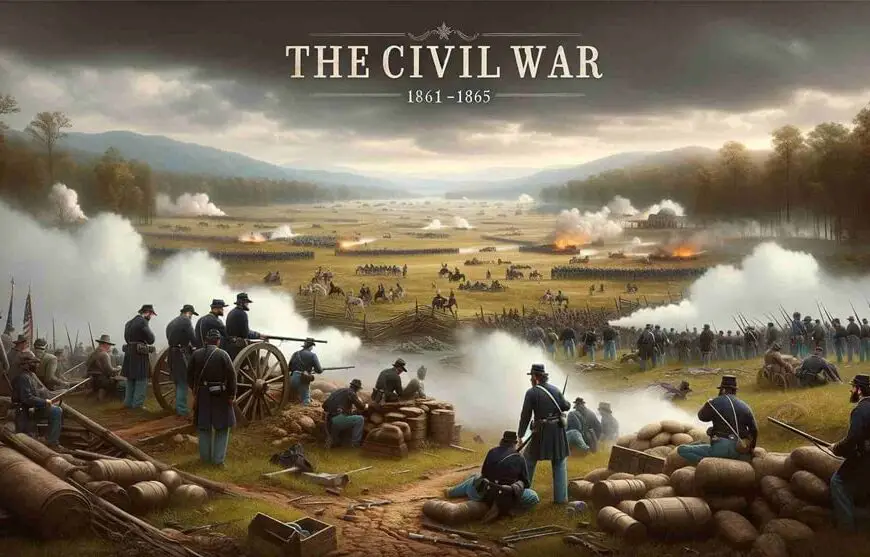The American Civil War of 1861–1865 stands as one of the defining moments in United States history and remains vivid in our memories today. Pitting Northern states, known as the Union, against Southern states, known as the Confederacy, for four long years of intense and bloody battles left an indelible imprint upon our political, social, and cultural landscape that continues to this day; 16 states comprised by the Northern Union against the Confederacy battled on opposing sides, resulting in irrevocably changing it forever afterward.
Slavery as the Unbridgeable Chasm
At the core of America’s Civil War was slavery, an issue that divided opinion from its inception. Southern states with predominantly agricultural economies relied on slave labor as essential to economic and lifestyle prosperity. In contrast, Northern states with more industrialized economies condemned slavery as a moral evil. They sought to limit its expansion, setting in motion an irreconcilable moral and economic divide that ultimately led to bloodshed on both sides. This created the impetus for violence, which followed soon after.
Another significant contributor to the Civil War was the tension between states’ rights and federal authority. Southerners – deeply committed to this concept of sovereign statehood – believed individual states had sovereign control of their destinies if they chose to secede from Union membership; on the other hand, Northerners asserted the importance of federal authority and believed secession illegal; this ideological battle deepened divisions further between North and South.
Economic Disparities and Sectionalism Economic disparities exacerbated regional tensions; while Northerners were rapidly industrializing while those in the South still mainly employed agriculture, this economic divergence led to differing priorities and interests, contributing to more significant tensions between them, eventually contributing to regional division.
II: Key Events and Turning Points
Fort Sumter: The Volatile Prelude
Hostilities began formally April 12, 1861, when Confederate forces fired shots upon Fort Sumter, a historic Union fort located within Charleston Harbor in South Carolina. This significant military engagement marked the official commencement of hostilities between the Union and Confederate forces.
Bull Run (First Manassas): An Early Shock
The first major battle of the Civil War, known as Bull Run to Northerners and First Manassas to Southerners, took place on July 21, 1861, near Manassas in Virginia. Contrary to initial expectations of a short conflict, this battle marked the beginning of a prolonged and extensive war. The Confederate victory at Bull Run shattered the North’s hope for a quick resolution, signaling that the conflict would be far longer and more brutal than either side had anticipated. This battle was a crucial moment that underscored the depth of the divide between North and South, setting the stage for the fierce and widespread fighting that would follow.
Emancipation Proclamation as a Moral Imperative
On January 1, 1863, President Abraham Lincoln issued the Emancipation Proclamation; this seminal document declared all enslaved people within Confederate-held territory to be free. Although not immediately freeing all individuals held captive, its passage shifted the war towards fighting for freedom while giving Union forces moral inspiration to fight it.
Furthermore, the experiences and perspectives of enslaved people, women, and other marginalized groups during the Civil War period present a more comprehensive picture of the era. Their struggles and contributions, often overlooked in traditional narratives, provide crucial insights into the human aspect of the war and its long-term societal impact. The war was not just a series of political and military events; it was also a crucible in which the lives of millions were profoundly altered
Gettysburg Was A Turning Point In the Civil War
Gettysburg, which took place from July 1-3 in Pennsylvania between 1863-1864, was one of the bloodiest battles during the American Civil War and saw Union victory, resulting in what is often cited as being one of the turning points that altered momentum towards their side of the conflict.
Appomattox Courthouse: The War’s Denouement
On April 9, 1865, General Robert E. Lee surrendered his Confederate army to Ulysses S. Grant at Appomattox Courthouse, Virginia; this ceremony marked its formal end and began a turbulent postwar aftermath.
Reconstruction
Following the Civil War, the Reconstruction era presented America with numerous complex challenges. While trying to reintegrate southern states back into the Union and secure civil rights for newly liberated African Americans while rebuilding the war-torn South, Reconstruction was often marked by political strife, violence, and white supremacist groups like the Ku Klux Klan, which began reappearing during Reconstruction.
Constitutional Amendments and Civil Rights
Reconstruction saw three key amendments added to the U.S. Constitution:
- Abolishing slavery (1865)
- Providing citizenship and equal protection under the law to individuals born or naturalized within its borders (1868)
- Prohibiting denial of voting rights on account of race (1870)
The Civil War not only redefined the nation’s political landscape but also had profound effects on American identity. It spurred a profound transformation in societal values, reshaping views on freedom, democracy, and what it means to be an American. This period marked the beginning of a long journey toward a more inclusive understanding of citizenship and human rights in the United States
The Lingering Legacy
The Civil War left an indelible imprint on American society. While slavery came to an end during its duration, civil rights for African Americans would take many more years before finally materializing as promised. Today, its legacy includes ongoing efforts for equality for all members of society as a reminder of those divisions that once tore it apart and an impetus to work towards creating more inclusive and equal communities. (IV. Healing and Reconciliation)
Memorialization and Remembrance
During the Civil War, America undertook an ambitious national memorialization program in honor of both fallen soldiers and to remember sacrifices on both sides. National cemeteries, monuments, and memorials were constructed as lasting symbols of reconciliation and memory.
Reconstruction’s Long Road to Reunion
Gradually, the wounds caused by the Civil War began to heal themselves. Reconciliation efforts took place with mixed success, eventually leading to national unification. Reconstruction created an inclusive and more united United States of America for future generations.
Lessons for Now and Tomorrow
The Civil War provides timeless lessons about division’s damaging consequences. It addresses its core causes, thus reinforcing dialogue, compromise, and commitments to justice and equality to heal a fractured nation.
Conclusion
The American Civil War was an intense, bloody, and life-altering chapter in American history. Fought over deep ideological, economic, and moral divisions between states, it ultimately resulted in one united, if scarred, nation that continued its struggle against slavery and discrimination despite having endured decades of pain before coming together again under President Lincoln as one. By studying its legacy today, we are reminded that reconciliation and progress can still occur even amid severe divisions; looking back can reveal steps for creating a more equitable future.











